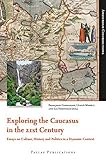Exploring the Caucasus in the 21st Century : Essays on Culture, History and Politics in a Dynamic Context / ed. by László Marácz, Francoise Companjen, Lia Versteegh.
Material type: TextSeries: Amsterdam ContributionsPublisher: Amsterdam : Amsterdam University Press, [2010]Copyright date: ©2010Description: 1 online resource (256 p.)Content type:
TextSeries: Amsterdam ContributionsPublisher: Amsterdam : Amsterdam University Press, [2010]Copyright date: ©2010Description: 1 online resource (256 p.)Content type: - 9789048511624
- 947.52
- online - DeGruyter
| Item type | Current library | Call number | URL | Status | Notes | Barcode | |
|---|---|---|---|---|---|---|---|
 eBook
eBook
|
Biblioteca "Angelicum" Pont. Univ. S.Tommaso d'Aquino Nuvola online | online - DeGruyter (Browse shelf(Opens below)) | Online access | Not for loan (Accesso limitato) | Accesso per gli utenti autorizzati / Access for authorized users | (dgr)9789048511624 |
Frontmatter -- Table of contents -- On the spelling, words and map in this book -- Map -- Introduction -- 1. Gábor Bálint de Szentkatolna (1844-1913) and the Study of Kabardian -- 2. The Ethnic-Political Arrangement of the Peoples of the Caucasus -- 3. An Island of Classical Arabic in the Caucasus: Dagestan -- 4. Chechnya and Russia, between Revolt and Loyalty -- 5. Recent Political History of the South Caucasus in the Context of Transition -- 6. Authoritarianism and Party Politics in the South Caucasus -- 7. Between State and Nation Building: The Debate about ‘Ethnicity’ in Georgian Citizens’ ID Cards -- 8. The War in South Ossetia, August 2008: Four Perspectives -- 9. The Recognition of Abkhazia and South Ossetia: A New Era in International Law -- 10. Freedom of Speech in the Caucasus: Watch-dog Needed in Armenia and Azerbaijan -- 11. Beyond Frontiers: Engagement and Artistic Freedom in South Caucasus Modern Culture (Armenia and Azerbaijan) -- List of Contributors
restricted access online access with authorization star
http://purl.org/coar/access_right/c_16ec
Situated between Russia, Turkey, and Iran and comprising part of the Russian Federation along with Georgia, Armenia, and Azerbaijan, the Caucasus region is best known for ethnic and religious divides that have resulted in bloody conflicts for centuries, most recently between various minorities and the post-Soviet independent states. This extensive volume reveals the rich and multifaceted nature of the Caucasus and includes a study of the region’s transition to independence; an exploration of the area’s religions; and a discussion of the role of art in war-torn communities. It is necessary reading for anyone with an interest in one of the world’s most complex regions.
Mode of access: Internet via World Wide Web.
In English.
Description based on online resource; title from PDF title page (publisher's Web site, viewed 01. Dez 2022)


